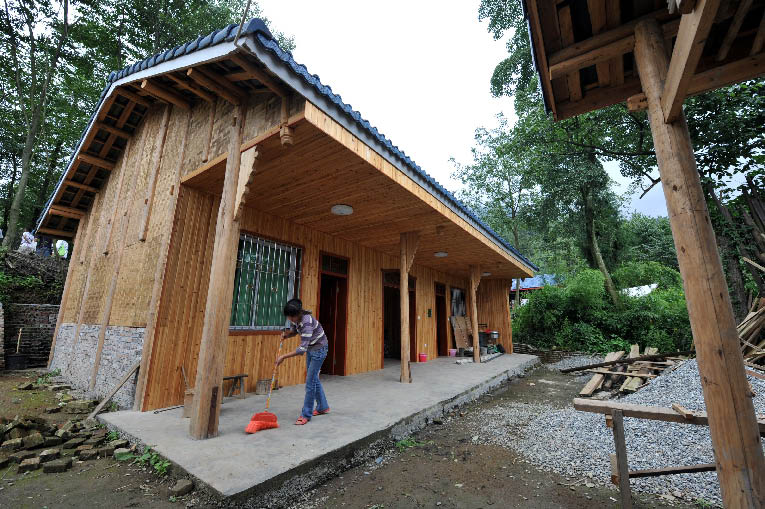|
Let's Do It!
 |
| He Jiao cleans her newly built eco-friendly house in Daping, the first low-carbon eco-demonstration village in China. |
According to a survey, over 30 percent of greenhouse gas emissions are from transportation sources; therefore choosing to take public transport is one of the most effective ways to reduce carbon dioxide. The 32-year-old Lin Rui prefers to go to work by subway everyday. "Three years ago I thought about buying a car, but finally I decided against it. The subway's more convenient and I can avoid the traffic jams," he explains. "Not just that, it helps save money! It costs me less than 100 yuan a month. If I had a car it would probably cost me more than ten times that in running costs alone, including gas and parking." The Beijing municipal government is working to encourage people to opt for public transport so as to reduce emissions from cars. It has set the price of subway fares at a flat two yuan with unlimited transfers, and bus passengers using the prepaid "Transport Card" pay a mere 0.40 yuan, saving 60 percent of the regular price.
Meanwhile, the creation of "low-carbon communities" is being advocated around the country. In August 2010, activities such as quizzes and interactive games were staged in the Jinyuchi Community in Beijing, the aim being to spread low-carbon awareness and to spread practical knowledge in an easy and interesting way.
Many Chinese businesses are offering services that support a low-carbon lifestyle. For example, Ctrip, a popular online travel website, provides a "carbon neutral" service. When buying a flight, Ctrip customers can check the amount of carbon emissions their trip will generate and neutralize it by exchanging their mileage points for saplings, which will be planted in Inner Mongolia by non-governmental organizations. According to Ctrip, within the first three months of the program more than 2,300 customers bought saplings this way. URBN, China's first carbon-neutral hotel, was opened in Shanghai at the end of 2007. The hotel offsets its carbon emissions by purchasing credits and investing in projects to help restore the environment and reduce carbon dioxide.
At the end of June 2010, Air China launched a green service from Beijing to Guangzhou. The company invited an authority agency to calculate the flight's carbon dioxide emissions and bought permits via the domestic carbon trading program to offset its greenhouse gas emissions. Also the cabin crew played a short video showing the energy-saving and conservation actions taken by the aviation industry.
Towards a Low-carbon Countryside
As well as in urban areas, the low-carbon lifestyle is gradually making headway in rural China. Daping Village in Sichuan's Tongji Town, a place heavily hit by the earthquake of 2008, is a case in point. It has been rebuilt as China's first low-carbon eco-village on a trial basis.
Daping Village sits on a 1,600-meter-high mountain in the southern sweep of the Longmen Mountains. The devastating earthquake left only 10 percent of its houses standing amid the rubble. In the reconstruction effort, the local government, residents, and non-governmental environmental groups jointly sponsored a "LOHO" housing program, which involves incorporating eco-housing, eco-economy and rural eco-management into the new low-carbon community arising from the devastation.
The walls of the LOHO (meaning happiness and harmony) homes are made of bamboo plywood and folded polystyrene, which maintain a steady indoor temperature and avoid using a lot of wood or bricks. Liu Jiaping, a professor of Xi'an University of Architecture and Technology and designer of the eco-friendly homes, tells China Today: "The construction materials selected for the rebuilding have low embedded energy and are right for the local climate. In this way, the balance of low-energy consumption and comfortable living has been achieved."
The LOHO eco-community is taking shape, and along with it a new production structure. After discussion experts and local villagers decided to develop eco-tourism, eco-agriculture and creative crafts to help rebuild the local economy. Now Daping organic vegetables and handkerchiefs embroidered by local women have entered city markets.
| 